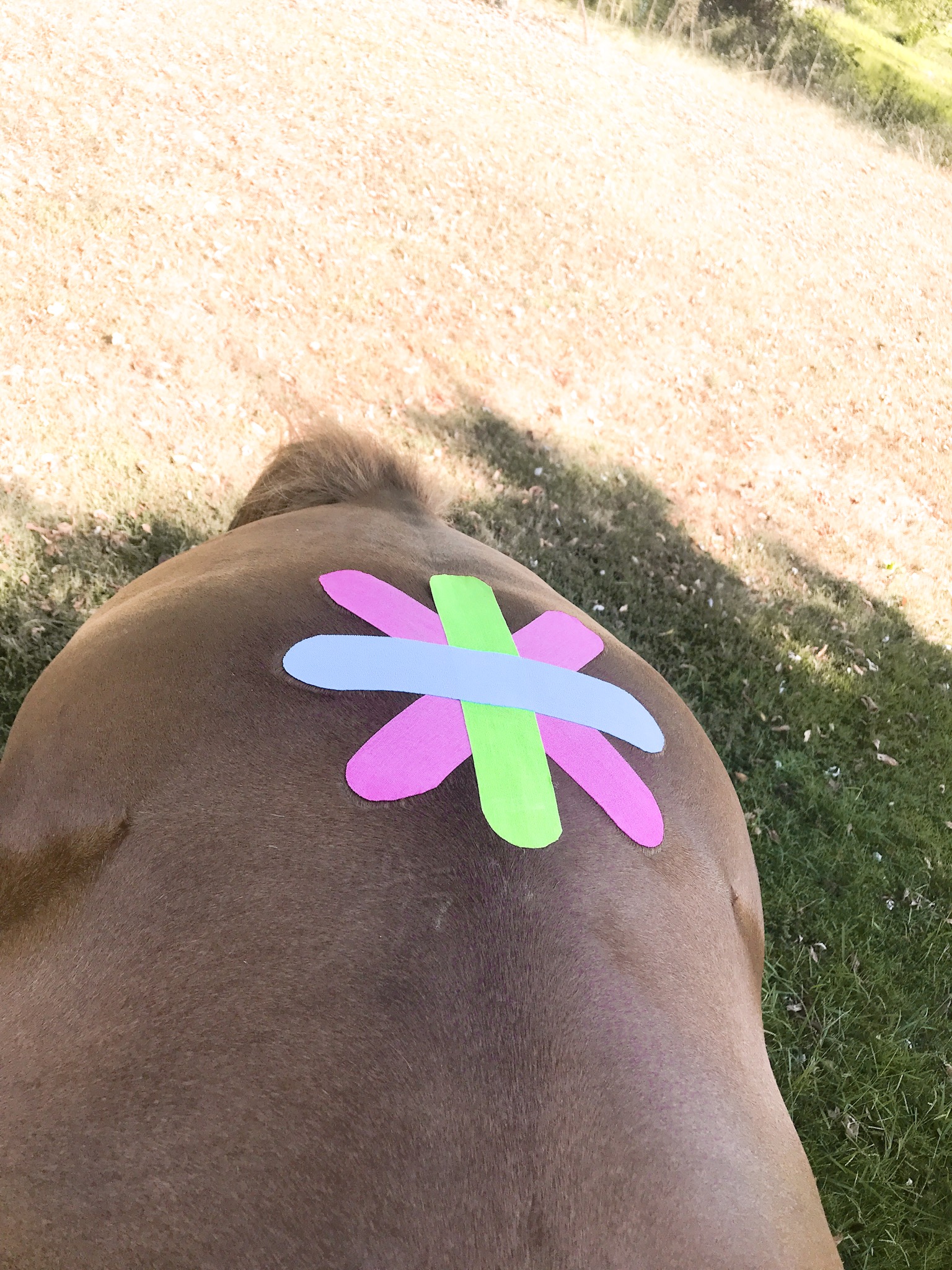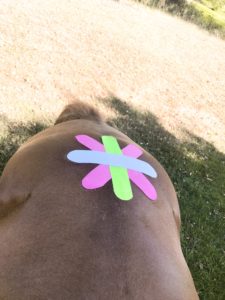
Muscle Tape For Horses
How did muscle tape start?
Kinesiology taping or muscle taping as I like to call it, is becoming quite popular today. The word “Kinesiology” is a Greek word with Kinesis meaning “motion” and “Logia” for study. The study of motion! Some may remember seeing Olympic athletes wear it but the knowledge behind it, what it does and how it works was a little fuzzy. For some, you just have to experience it for yourself. For others, they want more back-round information on this therapy. As we are learning about it and the benefits it has to offer the body, there are more than just athletes using and experiencing muscle tape. This modality has extended to our furry friends as well. Muscle taping is now widely popular in the canine and equine industry! Deformed legs are straightening, movement is improved and pain is being diminished. In Germany, dairy cows are being taped!
A Japanese Chiropractor created Muscle Tape. Dr. Kenzo Kase developed the tape with a Japanese company to help support and improve his Chiropractic adjustments. He saw that adjustments last longer and are more effective because the surrounding soft tissue and muscles are supported. Depending on the source you read you get a few different dates but roughly the 1970’s is when this started. By the end of the 1980’s, these tapes of different colors were worn by the Japanese and Chinese athletes. More attention was gained as athletes from all Nations wore tape. This was seen in the 2008 Olympic Games. Fast forward to the 2012 Olympic Games and this is now standard and accepted for most athletes to be taped.
What is the tape itself?
The tape itself is made from cotton fabric that is tightly woven. On the reverse side, it is coated with a specific latex and drug free acrylic adhesive. The adhesive is not an even coating throughout the back of the tape, but when looked at closely you can see the weave pattern that it has been applied in. This leaves some spacing between the adhesive allowing the material to breath and be permeable by water. The adhesive is activated by heat when applied to the patient, leading to a perfect adhesion of tape!
There are many different companies that create tape today with different cotton weaves and elasticity, and also many different colors. Originally, it was said that color didn’t matter in applications. Now, practitioners are noticing that after years of experience in applying, that there may be something to using different colors. There is such a therapy known as color therapy that dates back thousands of years. It is believed that this can have an effect on the length of time a tape stays adhered and the affect that color can have on the muscle.
How long does it last?
In general, muscle tape can last anywhere from 1-7 days on the body with normal activity such as showering and sports exercise. When it comes to animals, the tape has to withstand even more from the weather elements, mud, dirt and pasture friends who think they should play or pull the tape off their friend. I’ve personally had tape last up to 5 weeks or more on a horse and well over a week on myself if a covered area such as my back. The rule of thumb is to leave the tape adhered as long as it is doing its job. You can trim it as it starts to come off or remove it in the direction of the hair if necessary.
Muscle Tape is very similar to skin in its composition. Therefore, it mimics the thickness, elasticity and weight. Tape is considered a second skin and normal activities can be done after the tape is applied to the body because it does not restrict any movement or activity. The tape wasn’t always so forgiving as it was originally very thick, sturdy and rigid with very little elasticity. While it was supportive to joints or injury, it wasn’t supportive to range of motion, which is an important part of the healing process.
What does tape do?
There are many different techniques when it comes to the application of muscle tape. From the prep of the surface area to be applied, to where the tape is placed and how it may or may not be stretched during application. Depending on how and where the tape is applied, it can activate or relax the muscle activity. It is supportive to tendons and ligaments allowing range of motion and in fact, encouraging and improving it.
Anything that is stretched will have the tendency to recoil and lift the skin or hair of the patient. This is the basic effect. The outer lifting of the hair and skin creates space for the tissue beneath. This space allows blood, lymphatic fluid and waste to flow or flush more easily. This lifting effect can penetrate into deeper tissue layers. Studies have shown it to be effective not only on the surface level, but also deeper into the body as all the fascia is connected. Pressure and pain relief can be felt when this happens.
Are there taping benefits?
As I mentioned earlier, I would share some more benefits of muscle taping for you! Tape facilitates protection by limiting movement to protect damaged tissue by reducing pain and preventing further injury. It enables correction by helping to change the position of bony structures to activate muscles and improve movement patterns and quantity. While it reduces muscle imbalances in the joints and relaxes tight muscles, thus allowing more flexibility. It helps reduce swelling, inflammation, bruising and can aid in drainage and the flushing out of toxins along the lymph system. Tape is supportive during rehabilitation therapy, helping to prevent further injury. Muscle Tape supports regeneration, decreases muscle spasms and increases circulation. These benefits of Muscle Tape are astounding and all of these combined efforts speed up the healing process of the body or support it in general.
There are contraindications when it comes to this therapy just like most others. Times in which you would not apply tape would be if the person has certain skin conditions that would be fungal, parasitic or bacterial in nature. While tissues affected could benefit from tape, the spreading to other areas is a risk that should be avoided if possible. Some other contraindications are open wounds, fever, localized infections, pregnancy depending on area of application and tumors.
Who benefits from muscle tape?
In conclusion, muscle taping is a great support for a healthy body and a therapy for the healing body.
We are still learning and seeing the benefits as we continue to use it. I have personally experienced the positive effects of tape and witness it often in my job. While there are many therapies that can provide similar benefits to taping, it is less invasive.
For those seeking to burden the body with less toxins yet provide support, healing and relief at the same time, tape is a holistic option! Kinesiology taping is something that anyone and everyone can try. Some situations can be made worse if the tape is not applied correctly. When in doubt about muscle taping, you can contact a practitioner who has experience in this area. However, there are many books and videos out there that make it easy and simple to start. So, what are you waiting for? Start taping!
Book your session or learn more HERE

Bibliography
Caprano, C. (2013). Introduction to the Equine Kinesiology Taping Method. K-Active Europe GmbH
Bredlau-Morich, K. (2017). Kinesiology Taping for Horses. North Pomfret, Vermont: Trafalgar Square Books.
Katrine Kleven, H. (2019). Physical Therapy for Horses. North Pomfret, Vermont: Trafalgar Square Books.
